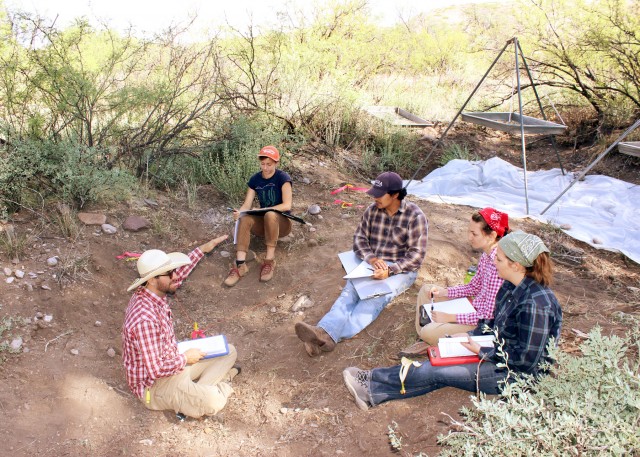- Home
- >
- Preservation Archaeology Blog
- >
- The Archaeology of Looting
Elissa McDavid, Hendrix College
(June 16, 2016)—Before arriving at field school, I had imagined well-preserved sites disturbed by nothing more than a few animal burrows, adobe walls and floors that behaved nicely, and no looting. (Blame National Geographic glamour and the fact that no one really wants to publish the holes—literal or figurative—in our sites and our knowledge.) Animal burrows and hard-to-see adobe walls and floors are one thing, but what has surprised me the most has been the aspects of destruction and the insights that can come from looting.
Most sites along the Gila River in our area have been looted. At the Gila River Farm site where our excavations are focused, we have at least a few known areas of pot hunting. Lewis’s crew’s initial test unit was located in a hand-dug looter’s pit. The rest of our excavation area also has evidence of disturbance from heavy equipment. On the smaller sites we have visited on field trips, we encountered areas of both hand-dug and mechanical looting. I’ve heard staff members say that it is easier to forgive hand dug looters’ pits, but mechanical looting with heavy equipment like bulldozers destroys so much more.

The incentive to do this can vary from the monetary value of recovered items to a lack of knowledge about what is lost by destroying the archaeological record. In some cases, people who dig without documenting their excavations do not see themselves as looters, but as preserving the history of the area, as they have no intention of selling the pots they recovered. These objects might have been collected with good intentions and passed down through several generations.
This situation is not unique to the area where we are working. After all, in some way, many of us might have indirectly contributed to the destruction of sites as urbanization covers more of the landscape, or otherwise unintentionally contributed to activities that do not support the culture of our past. One thing I have come to realize in my very short time in Southwestern archaeology is the importance of understanding looting pits as another feature of a site.
Last week, I participated in archaeological survey work that documented several looted sites. On our first day, we found a site on a bench across from the Gila River. After mapping the site’s architecture, we looked around and realized around 40 percent of the site had been impacted by looting. The next day we came across another, smaller site that looked like it had been bulldozed.

The experience of mapping sites by hand and with GPS equipment made realize how crucial spatial information is in understanding an ancient site. We can also puzzle out some of the answers to how more recent people see or saw the land by examining looting activities. If the looting took place during the last hundred years, this often reveals itself in glass, metal, and other artifacts. Modern artifacts can show up as well. The dichotomy between ancient architecture and artifacts that have lasted for centuries and architecture and artifacts that modern-day people have destroyed is difficult to wrap one’s head around. To me, archaeology is not just about trying to understand the people of the past. Maintaining dialogues with modern-day people is an essential part of archaeology, as well.
Explore the News
-
Join Today
Keep up with the latest discoveries in southwestern archaeology. Join today, and receive Archaeology Southwest Magazine, among other member benefits.